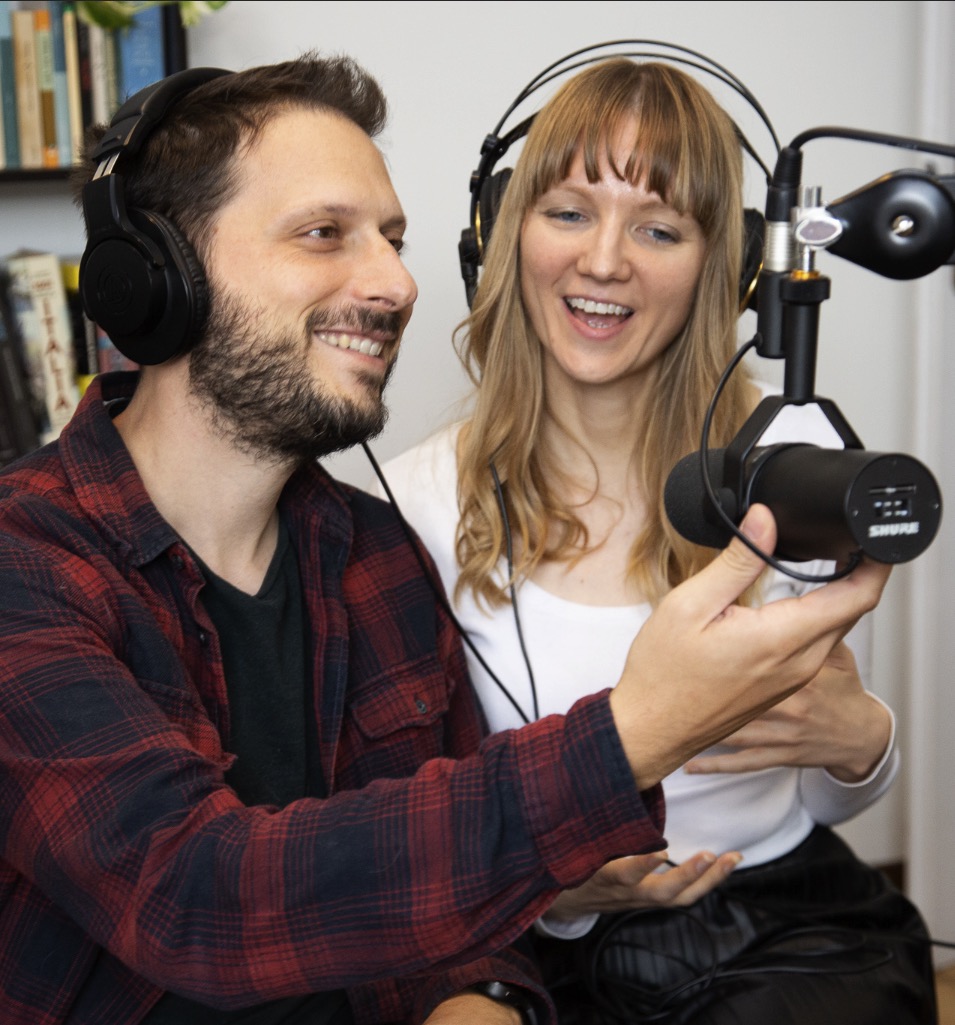Mi piace. It’s simple enough to remember this phrase in the present, but in the past, things get a little tricky! Learn how to talk about things you liked in this episode. By the end, you’ll be able to say things like: “I liked it” and ask people: “did you like it?”
Become a 5-minute Italian member (it's free!)
Learn to speak and understand Italian faster by joining the 5 minute Italian club! When you sign up, you'll get:
- Mini Italian lessons + bonus materials delivered to your inbox.
- Access to the private Facebook group where you can practice chatting in Italian.
- Invites to free speaking workshops.
If you'd like to join us, click here to become a member of 5 Minute Italian.
Vocabulary: Piace in the past
- Qual è l’ultimo film che hai visto = What’s the last film you saw?
- Qual = which
- È = is
- L'ultimo = the last
- Film = film or movie
- Che = that
- Hai = you have
- visto = seen
- Ti è piaciuto? = Did you like it?
- Ti = to you
- È = it is
- Piaciuto = pleased
- Gli è piaciuto = he, they liked it
- Gli = to him, them
- È = it is
- Piaciuto = pleased
- Le è piaciuto = she, you formal liked it
- Le = to her, you formal
- È = it is
- Piaciuto = pleased
- Ci è piaciuto = we liked it
- Vi è piaciuto = you liked it (plural, for speaking to more than one person)
Quiz: Piace in the past
How much did you learn? Find out in the 5-minute Italian quiz!
Click here to take the quiz for this episode: Piace in the past
Flashcards: Piace in the past
Remember the vocabulary from your 5 Minute Italian lessons by downloading the digital flashcards
Not sure how it works? Click here to watch the tutorial
Transcript: Piace in the past
Please note, this is not a word for word transcript.
Katie: Ciao a tutti e benvenuti a 5 Minute Italian. I’m Katie.
Matteo: And I’m Matteo. Ciao!
K: In today’s episode, you’ll learn how to talk about things you liked (and ask other people about things they liked) in the past. Let’s start with a mini conversazione.
K: Matteo, qual è l’ultimo film che hai visto?
M: L’ultimo di Star Wars.
K: Ti è piaciuto?
M: Non molto.
K: The first line you heard was:
M: Qual è l’ultimo film che hai visto.
K: What’s the last film you saw? Literally:
Qual = which
È = is
L'ultimo = this is broken down into two words: L apostrophe which means “the” and ultimo which means last.
Film = film or movie
Che = that
Hai = you have
visto = seen
K: And the film was:
M- L’ultimo di Star Wars.
K: The last, or most recent Star Wars.
K: Then I asked Matteo:
M: Ti è piaciuto?
K: Did you like it? And he said
M: Non molto.
K: Not much.
Let’s come back to the question, Ti è piaciuto? If you listened to the last episode, you’ll know that in Italian, this phrase is actually a little more like saying “did it please you?”. Literally:
M:
Ti = to you
È = it is
Piaciuto = pleased
K: And here we come to the main theme of today’s lesson. Using the word “piace” in the past. The first thing we need to do is stop thinking of it in an English way, as in “like” and think of it more in the Italian way: the thing pleases us, or in this case, it pleased us.
I want to know, did you like the film? In Italian, the structure would be, to you, it pleased? We start with the person, in this case, “to you”, which in Italian is:
M: Ti
K: Then we need to change the verb into the past. To make the past in Italian, we need a helper verb that comes before the main verb. For piacere, we use è, which literally means “it is”. So we get:
M:
Ti = to you
È = it is
K: Then we need to change the ending of piacere to make it a past form. Kind of like changing it from “please” to “pleased”. To change piacere into the past, we get:
M: Piaciuto.
K: Peee - aaaa - chooo - toh.
M: Piaciuto.
K: So again, did you like it, or “to you, it pleased?”, we start with the person, to you:
M: Ti
K: Then we add the helper verb, in this case “it is”:
M: è
K: Then we change piacere (to please) into the past, to get “pleased”
M: Piaciuto.
K: Ti è piaciuto?
M: Ti è piaciuto?
K: And just like last week, we can change the person, to talk about different people liking things, or literally, things pleasing different people. So how would you say “I liked it”. Literally, to me, it pleased:
M: Mi è piaciuto
Mi = to me
È = it is
Piaciuto = pleased
K: You liked it?
M: Ti è piaciuto
Ti = to you
È = it is
Piaciuto = pleased
K: He liked it? To give you a little reminder from the last lesson, to say “he liked it”, we need to say “to him, it pleased”. “To him” is an indirect object and it starts with the letter g (even if we don’t pronounce it like a g.).
M: Gli.
K: G - L - I - pronounced like an L that glides across the top of your mouth. To him is gli.
K: So he liked it “to him it pleased”?
M: Gli è piaciuto
Gli = to him
È = it is
Piaciuto = pleased
K: And we know that the indirect object for “to him” is exactly the same as “to them”. This means that to say “he liked it” and “they liked it”. “To him it pleased” and “to them it pleased” is exactly the same. So to say “they liked it”, we’d say…
M: Gli è piaciuto
Gli = to him or to them
È = it is
Piaciuto = pleased
K: Now let’s talk about “she liked it”. Can you remember the indirect object for her? To say “to her” in Italian, we say..
M: Le
K: Spelt L - E. To say “she liked it”, we’d get…
M: Le è piaciuto
Le = to her
È = it is
Piaciuto = pleased.
K: And we have a formal “you” - that’s used in Italian when you’re speaking to older people you don’t know very well or customers etc. It’s exactly the same as the “she” form. So how might a receptionist in a hotel or a waiter ask you “did you like it?”
M: Le è piaciuto?
K: And in the formal, that’s the same for both men and women.
M: Le è piaciuto?
K: Next, we liked it, literally “to us, it pleased”. I’ll give you a little hint, first… can you remember how to say “to us”? It’s “ci”.
M: Ci è piaciuto
Ci = to us
È = it is
Piaciuto = pleased
K: Finally, time for the “you plural”, which is when you’re speaking to two or more people in Italian. To say “to you” in the plural, we get….
M: Vi.
K: So to say “you liked it”, as in, you all or both liked it, we’d get:
M: Vi è piaciuto
Vi = to you plural
È = it is
Piaciuto = pleased.
M: Let’s review all these quickly.
K: Buona idea. I liked it is:
M: Mi è piaciuto
K: You liked it:
M: Ti è piaciuto
K: He, or they liked it:
M: Gli è piaciuto
K: She liked it, or you liked it in the formal address:
M: Le è piaciuto
K: We liked it:
M: Ci è piaciuto
K: You liked it, when you’re speaking to two or more people?
M: Vi è piaciuto.
K: We’ve just covered the basics, but there are a few more details that are good to know in order to use “piace” correctly in the past, and we’ll talk about these in the next lesson.
Remember, if you’d like to see all this stuff written down, on our website you’ll find the transcripts for this episode and other bonus materials like a quiz and flashcards to help you remember the phrases. Go to www.joyoflanguages.com/italianpodcast and scroll down to episode 83. If you’d like to get a free mini Italian lesson like this one every Sunday, you can join our newsletter too - you’ll find the link in the show notes.
See you next time, or as we say in Italian
Alla prossima!
Get more 5-minute Italian
To get more 5 minute Italian, including lessons delivered to your inbox, access to the private Facebook group and invites to speaking workshops, click here to become a 5 Minute Italian member.
Related episodes
Indirect object pronouns in Italian (mi, ti, le, gli, ci, vi)

